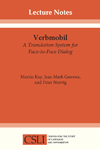

|
|
|
|

VerbmobilA Translation System for Face-to-Face Dialog Verbmobil is a portable simultaneous interpreter. Carry it to a meeting with speakers of other languages and it will translate your spoken words for them. Their Verbmobils, if they have them, will allow you to understand what they are saying. So far, Verbmobil exists only as a research program of the Bundesministerium für Forschung und Technologie, Germany's Federal Ministry of Research and Technology. If the program's goals are met, the first experimental prototypes, with restricted capabilities, will exist at CSLI to assess the realistic chances of success for the Verbmobil program. The authors give an overview of the new discipline of speech-based machine translation. They survey the state of the art in the separate fields of machine translation and speech recognition and evaluate the major obstacles to further progress in both fields. A chapter is devoted to the special problems of integrating speech recognition and natural language systems within the context of machine translation. Their appraisals and recommendations of the Verbmobil project are required reading for computer scientists and linguists. is a professor of linguistics at Stanford University, a research fellow at Xerox Palo Alto Research Center, and the permanent chair of the International Committee on Computational Linguistics. is a research linguist at SRI International. is a senior computer scientist for Sun Microsystems Labs. Contents
1/1/94 ISBN (Paperback): 0937073954 (9780937073957)
Subject: Linguistics; Machine Translating; Automatic Speech Recognition |
Distributed by the
University of Chicago Press |
|
pubs @ csli.stanford.edu
|
CSLI Publications
Stanford University Cordura Hall 210 Panama Street Stanford, CA 94305-4101 (650) 723-1839 |